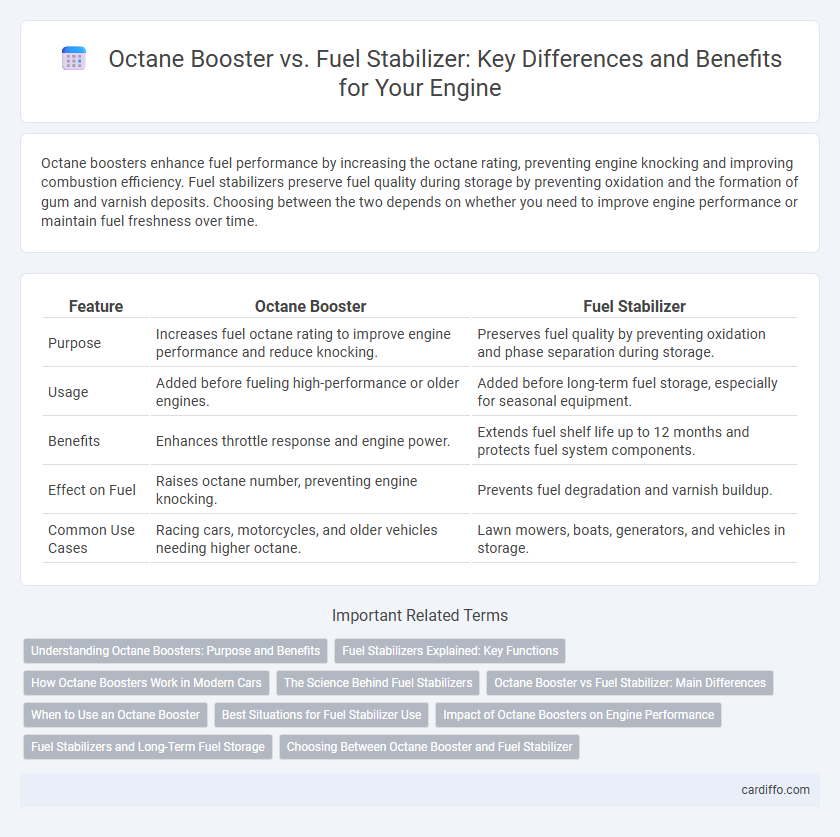Octane boosters enhance fuel performance by increasing the octane rating, preventing engine knocking and improving combustion efficiency. Fuel stabilizers preserve fuel quality during storage by preventing oxidation and the formation of gum and varnish deposits. Choosing between the two depends on whether you need to improve engine performance or maintain fuel freshness over time.
Table of Comparison
| Feature | Octane Booster | Fuel Stabilizer |
|---|---|---|
| Purpose | Increases fuel octane rating to improve engine performance and reduce knocking. | Preserves fuel quality by preventing oxidation and phase separation during storage. |
| Usage | Added before fueling high-performance or older engines. | Added before long-term fuel storage, especially for seasonal equipment. |
| Benefits | Enhances throttle response and engine power. | Extends fuel shelf life up to 12 months and protects fuel system components. |
| Effect on Fuel | Raises octane number, preventing engine knocking. | Prevents fuel degradation and varnish buildup. |
| Common Use Cases | Racing cars, motorcycles, and older vehicles needing higher octane. | Lawn mowers, boats, generators, and vehicles in storage. |
Understanding Octane Boosters: Purpose and Benefits
Octane boosters increase a fuel's octane rating, preventing engine knocking and improving performance in high-compression engines. They enhance combustion efficiency, leading to smoother acceleration and potentially better fuel economy. Unlike fuel stabilizers, octane boosters do not prolong fuel shelf life but focus solely on optimizing fuel combustion properties.
Fuel Stabilizers Explained: Key Functions
Fuel stabilizers prevent fuel degradation by inhibiting oxidation and the formation of varnish and gum deposits, ensuring optimal engine performance during storage. They extend fuel life by maintaining chemical integrity, reducing moisture buildup, and preventing corrosion in fuel systems. Applying fuel stabilizers is essential for seasonal equipment and vehicles stored for extended periods to avoid costly repairs and maintain fuel efficiency.
How Octane Boosters Work in Modern Cars
Octane boosters increase the fuel's octane rating, preventing engine knocking by enhancing combustion efficiency in modern cars. These additives raise the fuel's resistance to premature ignition, allowing engines to run smoother and maintain optimum performance under high compression. Modern direct-injection and turbocharged engines particularly benefit from octane boosters due to their higher compression ratios and ignition timing demands.
The Science Behind Fuel Stabilizers
Fuel stabilizers contain chemical additives that prevent oxidation and degradation of hydrocarbons, preserving fuel quality during storage. These additives inhibit the formation of gums and varnishes, which can clog fuel injectors and carburetors, ensuring optimal engine performance. By maintaining fuel's chemical integrity, stabilizers extend the shelf life and prevent phase separation in ethanol-blended fuels.
Octane Booster vs Fuel Stabilizer: Main Differences
Octane boosters increase the fuel's octane rating, enhancing combustion efficiency and preventing engine knocking in high-performance engines. Fuel stabilizers preserve the fuel's quality by preventing oxidation and degradation during storage, extending the shelf life of gasoline. While octane boosters improve engine performance, fuel stabilizers primarily protect fuel from stale conditions and contaminants.
When to Use an Octane Booster
Use an octane booster when your engine experiences knocking, pinging, or pre-ignition due to low-octane fuel, especially in high-performance or turbocharged vehicles that demand higher compression ratios. Octane boosters increase the fuel's resistance to premature ignition, enhancing engine efficiency and performance under heavy load or extreme conditions. Avoid relying on octane boosters for long-term fuel preservation, as fuel stabilizers are better suited for maintaining fuel quality during storage and preventing degradation.
Best Situations for Fuel Stabilizer Use
Fuel stabilizer is best used for long-term storage of gasoline-powered equipment, such as lawnmowers, motorcycles, and boats, where fuel degradation and varnish buildup can impair engine performance. It prevents oxidation and phase separation in ethanol-blended fuels, ensuring the gasoline remains fresh for up to 12 months. Ideal for off-season storage or during periods of inactivity, fuel stabilizers protect fuel systems and extend engine life.
Impact of Octane Boosters on Engine Performance
Octane boosters increase the fuel's octane rating, reducing engine knock and improving combustion efficiency, which enhances overall engine performance and power output. Using octane boosters can prevent pre-ignition and knocking in high-compression engines, promoting smoother acceleration and increased fuel economy. Unlike fuel stabilizers that preserve fuel quality during storage, octane boosters directly influence combustion dynamics for optimized engine responsiveness.
Fuel Stabilizers and Long-Term Fuel Storage
Fuel stabilizers are essential for preventing fuel degradation during long-term storage by inhibiting oxidation and varnish formation. They maintain fuel quality for extended periods, typically up to 12-24 months, ensuring engine performance and easier startups after storage. Unlike octane boosters, which enhance combustion efficiency, fuel stabilizers preserve fuel integrity, making them ideal for seasonal equipment and stored vehicles.
Choosing Between Octane Booster and Fuel Stabilizer
Choosing between octane booster and fuel stabilizer depends on your engine's needs: octane boosters increase fuel's octane rating, enhancing combustion efficiency and preventing knocking in high-performance engines, while fuel stabilizers preserve gasoline quality during storage by preventing oxidation and varnish buildup. For vehicles stored long-term or used infrequently, fuel stabilizers are essential to maintain fuel integrity and engine performance. High-performance or turbocharged vehicles benefit more from octane boosters to optimize power output and prevent pre-ignition issues.
Octane Booster vs Fuel Stabilizer Infographic

 cardiffo.com
cardiffo.com